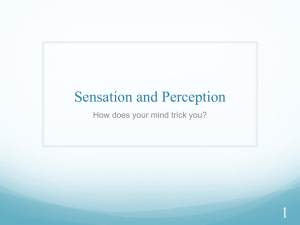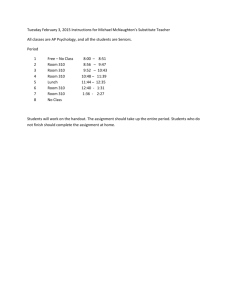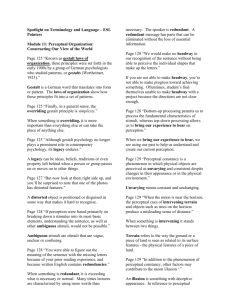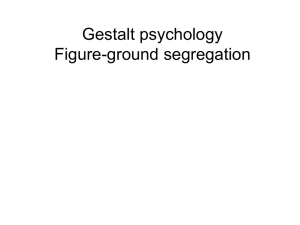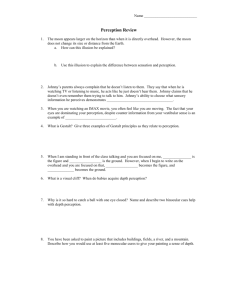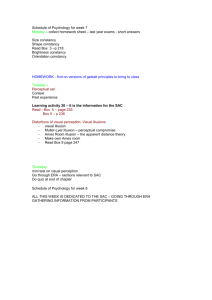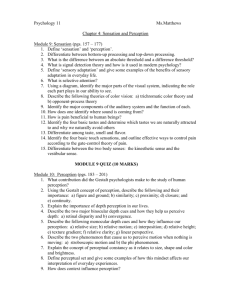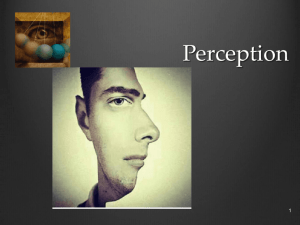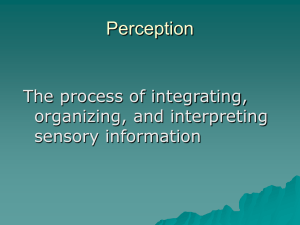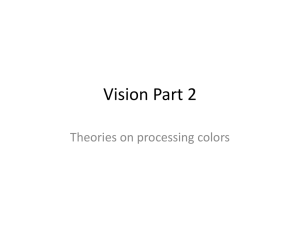4.3 Reading Guide
advertisement
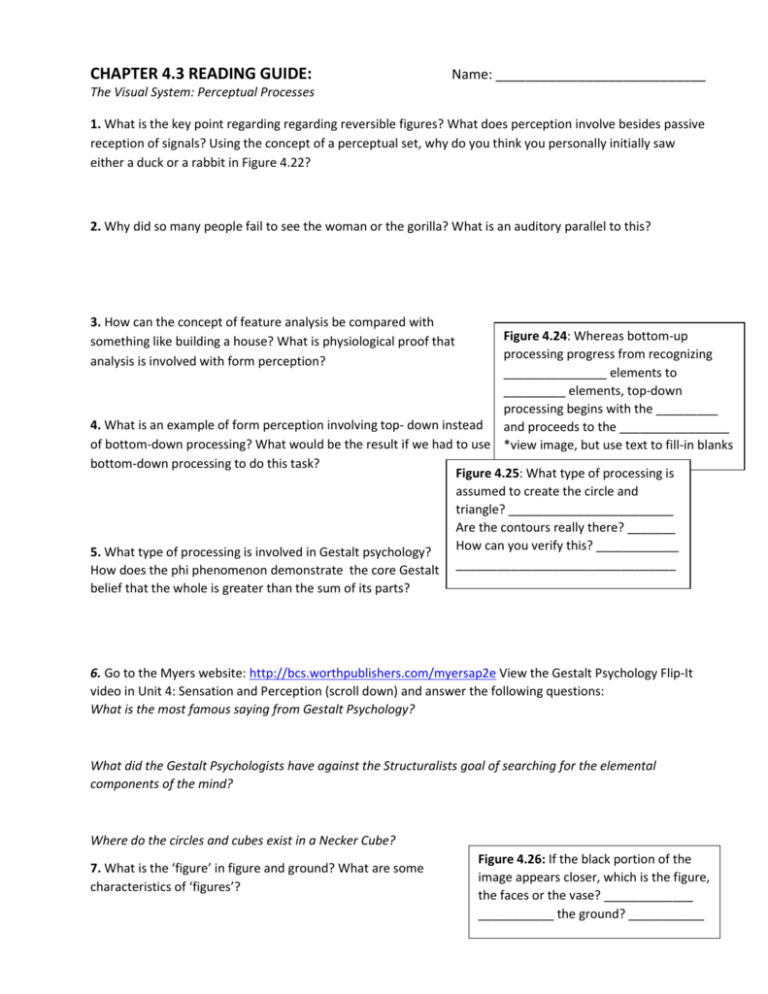
CHAPTER 4.3 READING GUIDE: Name: ____________________________ The Visual System: Perceptual Processes 1. What is the key point regarding regarding reversible figures? What does perception involve besides passive reception of signals? Using the concept of a perceptual set, why do you think you personally initially saw either a duck or a rabbit in Figure 4.22? 2. Why did so many people fail to see the woman or the gorilla? What is an auditory parallel to this? 3. How can the concept of feature analysis be compared with something like building a house? What is physiological proof that analysis is involved with form perception? Figure 4.24: Whereas bottom-up feature processing progress from recognizing _______________ elements to _________ elements, top-down processing begins with the _________ 4. What is an example of form perception involving top- down instead and proceeds to the ________________ of bottom-down processing? What would be the result if we had to use *view image, but use text to fill-in blanks bottom-down processing to do this task? Figure 4.25: What type of processing is assumed to create the circle and triangle? ________________________ Are the contours really there? _______ How can you verify this? ____________ 5. What type of processing is involved in Gestalt psychology? How does the phi phenomenon demonstrate the core Gestalt ________________________________ belief that the whole is greater than the sum of its parts? 6. Go to the Myers website: http://bcs.worthpublishers.com/myersap2e View the Gestalt Psychology Flip-It video in Unit 4: Sensation and Perception (scroll down) and answer the following questions: What is the most famous saying from Gestalt Psychology? What did the Gestalt Psychologists have against the Structuralists goal of searching for the elemental components of the mind? Where do the circles and cubes exist in a Necker Cube? 7. What is the ‘figure’ in figure and ground? What are some characteristics of ‘figures’? Figure 4.26: If the black portion of the image appears closer, which is the figure, the faces or the vase? _____________ ___________ the ground? ___________ 8. According to the principle of proximity, why do people tend to perceive rows instead of columns in Figure 4.27(a)? What wouldn’t we see in Figure 4.27(c) if similarity didn’t occur? What does the principle of continuity lead viewers to see in Figure 4.27(e)? Why? 9. Look at Figure 4.28. How does the concept of ‘perceptual hypotheses’ explain how all three of the retinal images will be perceived as the same square? Look at Figure 4.31. How does the context of the surrounding letters create an expectation that leads many people to read the second word as CAT (not that there’s anything wrong with that)? What’s the error on page 153? 10. Why are two cameras used to film the same scene for 3D movies (how does this mimic binocular depth cues)? What happens to retinal disparity when an object moves closer? According to convergence, what do we sense happening to our eyes as they focus on this object? 11. Concept Check 4.2: Describe how Van Gogh used each of the following pictorial depth cues in his painting Corridor in the Asylum (yes, you can cheat on this, but try to do it on your own first and then correct any mistakes). 1. interposition: Figure 4.32: Besides the stated depth 2. height in plane: cue, what is another cue you can see in the following pictures: Linear Perspective: ________________ Texture Gradient: _________________ 3. texture gradient: Interposition: ____________________ Relative Size: _____________________ 4. relative size: Height in Plane: ___________________ 5. light and shadow: What happens to the crater in the light and shadow picture when you turn the book upside down? ________________ ________________ 6. linear perspective: *the Myers website has a flip-it video on monocular cues you can watch if you want (no questions asked). 12. Read the last paragraph on page 153 and view Figure 4.33 on page 155. Why did the South African Bantus believe the hunter was trying to spear the elephant (specifically, what didn’t they understand)? Why didn’t they understand these? Besides cultural variations, how else can judgments of distance be subjective? 13. What are some things that people tend to view as being stable despite variations in sensory input? 14. In the Muller-Lyer illusion, how do we perceive the two figures in terms of distance? If our retina sees two lines that appear to be the same length, but one seems to be closer, what does the mind assume? Using Figure 4.34 as a guide, draw your own Muller-Lyer illusion. 15. In an Ames room, what do viewers looking from the correct point see? What is the reality of the left corner in relation to the right corner? Despite this reality, what do viewers see when two similar-size people stand in the opposite corners? 16. What process leads you to initially view an impossible figure as reasonable? Why? What happens as you build the features into a whole? Figure 4.37: What is our brain assuming about the monster who looks to be further away? ________________ ________________ Is this assumption correct? _________ Figure 4.39: Draw one of the impossible figures below. 17. Why does the misperception that the moon looks further away its on the horizon make it seem to be larger? 18. How does the picture at the bottom of p. 158 help explain why the people who live in that environment are less likely to be affected by the Muller-Lyer illusion? when Does your drawing exist? _____ Where? ___________ Where doesn’t it exist? _____________
